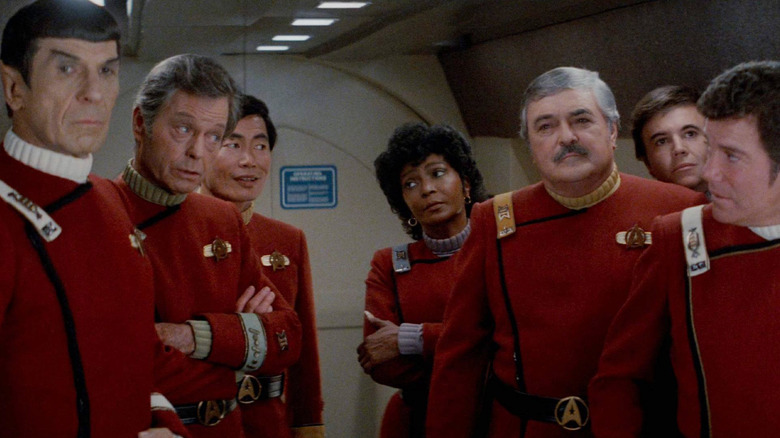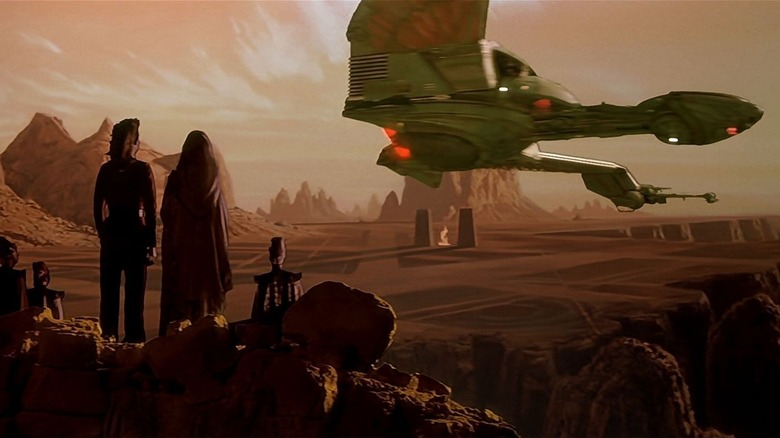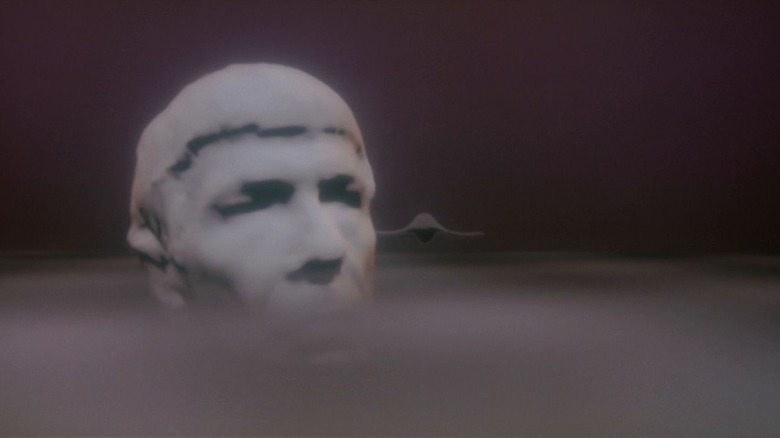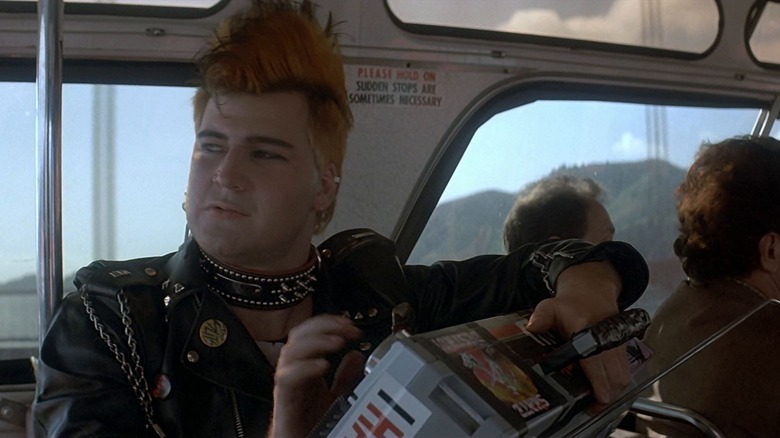Who Really Wrote Star Trek IV: The Voyage Home? The BTS Controversy Explained
There are four credited screenwriters on Leonard Nimoy's 1986 time travel comedy "Star Trek IV: The Voyage Home." Steve Meerson and Peter Krikes were hired together to write the film and they followed all the appropriate studio mandates, careful to write a role specifically for Eddie Murphy — he had expressed interest in appearing — and to beef up Admiral Kirk's role to appease a snippy William Shatner. Meerson and Krikes met with Nimoy and producer Harve Bennett early in production to bang out a story, and the quartet ultimately invented the plot: the Enterprise crew would travel back in time to the present day to retrieve a pair of humpback whale, a species that is extinct in the 23rd century. They must do this to appease a mysterious space probe that is draining the Earth's oceans.
Bennett and Nicholas Meyer are also credited as screenwriters, as they reworked a lot of Meerson and Krikes' script into something they felt was more "Star Trek"-appropriate. Bennett went on record saying that very little of the original script made its way into the final film, noting that the Eddie Murphy character was written out and that few of Meerson and Krikes' scenes survived. In fact, Bennett claimed that only two scenes from the original draft made their way to the screen, and those scenes were still at least slightly altered by him and Meyer.
In the oral history book "Captains' Logs: The Unauthorized Complete Trek Voyages," edited by Mark A. Altman and Edward Gross, Meerson and Krikes went on record saying that Bennett misrepresented their contributions. According to them, they did indeed lay out the general structure of the film, outlined key scenes, and even invented one of the movie's funniest moments.
Yes, alterations were made, but Meerson and Krikes were miffed by Bennett's comments.
Harve Bennett's claims to Star Trek IV
Bennett claimed that Eddie Murphy's initial involvement was great, but that when he dropped out, it was up to him and Meyer (the director of "Star Trek II: The Wrath of Khan") to salvage the script. Indeed, when describing the original script, Bennett was forwardly dismissive:
"We went through every writer we could think of. We finally found Steve Meerson and Peter Krikes, whose work was highly regarded. Nothing came of it. Some of that, in fairness to them, was because we had saddled them with what appeared to be a male character that we thought was going to be Eddie Murphy at one time. Then when Eddie Murphy fell out, we had to readjust the script. But, by then, it had turned to paste, it just didn't work."
Bennett even went so far as to detail the only two scenes he deigned to leave in his version of the script — the hospital scene, wherein an injured Chekov (Walter Koenig) has to be rescued before 20th century medicine injures him, and a scene in a plexiglass plant wherein Scotty (James Doohan) helps a 20h century engineer invent transparent aluminum. In his own words:
"Frankly, there are two scenes in the picture that they wrote that stayed pretty much the same. One of them is outstanding, which is the hospital scene that had minor modifications by Nick Meyer and me. They had also laid down the outline for the plexiglass factory scene. But, essentially, we didn't have a script we felt good about or even submittable to the studio."
The problem with Bennett's comments is that, at least according to Meerson and Krikes, they were lies. Their script contained way more of the final film than Bennett let on.
Steve Meerson and Peter Krikes' side of the story
Meerson went on record, saying:
"Actually, [...] every beat of the film's first, second and third acts is exactly the same as our script. The only thing that changed slightly was that our Eddie Murphy character and the marine biologist were combined. Eddie Murphy was going to play a college professor who taught English, but a professor who we probably all had in the '60s or '70s, who's a little bit wacky and believes in extraterrestrials. Every Wednesday, he would open up his class to a discussion and the room would light up with conversation."
The marine biologist character was to be a sidekick to Dr. Gillian Taylor, the character played by Catherine Hicks. Dr. Taylor was meant to serve as a love interest for Admiral Kirk (William Shatner), while Eddie Murphy's wacky teacher was to be the one to figure out that Kirk is from the future. The Murphy character was also going to be the one to stow away on board the Klingon ship Kirk came to 1986 in. Meerson even explained that Murphy was to bid Kirk farewell near the end of the movie before leaping into Kirk's transporter beam at the last second. Murphy was to stay in the 23rd century.
Eventually, those scenes were shunted over to Dr. Taylor, including the scene where she leaps into Kirk's transporter beam at the last second. She also, like Murphy, stayed in the 23rd century. The only notable cut scenes written by Meerson and Krikes were comedic ones built around Murphy's talents. His character, for instance, always believed in the existence of aliens, but when real aliens beam into his classroom, no one believes him.
Most everything else was (supposedly) intact.
The punk scene in Star Trek IV
Meerson even noted that he and Krikes wrote one of the film's funniest moments. In "Star Trek IV," Kirk and Spock ride on a San Francisco bus and have trouble talking because a punk rocker in a leather jacket is listening to a boombox at full volume. Kirk requests that the volume be reduced and the punk (played by associate producer Kirk Thatcher) flips him the bird in response. Spock then administers a Vulcan nerve pinch, knocking the punk and, in turn, his boombox out (which everyone else on the bus applauds). As Meerson put it:
"You know when Spock nerve pinches the guy on the bus? In our draft that took place in an underground subway system [...] You can't imagine the frustration of watching them take all the credit for something that was completely blocked out for them."
Meyer, meanwhile, claims the punk scene started its life in the script for his 1979 time travel film "Time After Time," but that the scene was ultimately cut. He said as much in a 1987 issue of Cinefantastique. Elsewhere, on the commentary track for "Star Trek IV," Nimoy claims that he invented the punk-pinching scene, recalling a real-life punker on a subway and "I thought if I was Spock I'd pinch his brains out!" Thatcher himself maintains that it was his idea that, when the punk was knocked unconscious, he turned off the music with his falling face.
Thatcher also composed the song in that scene, an aggressive ditty called "I Hate You." The authorship of the punk scene may be illuminated by the following trivia: "I Hate You" also turned up in the 1987 film "Back to the Beach," which was written by Meerson and Krikes.



